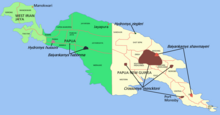
Michael Rogers Oldfield Thomas was a British zoologist.

The Old World rats and mice, part of the subfamily Murinae in the family Muridae, comprise at least 519 species. Members of this subfamily are called murines. In terms of species richness, this subfamily is larger than all mammal families except the Cricetidae and Muridae, and is larger than all mammal orders except the bats and the remainder of the rodents.

Leptomys is a genus of rodent endemic to New Guinea. It is considered part of the New Guinea Old Endemics, meaning it was part of the first wave of murine rodents to colonize the island. Leptomys are seen to have minimal adaptations to their aquatic life style. Elongated hind feet accompanied by elongated centre toes suggest the ability to leap. The third molar which is lost is many rodents is retained, albeit smaller. Small eyes and ears can be seen amongst its velvety soft fur.

The New Guinea waterside rat is the only species in the genus Parahydromys. It is considered part of the New Guinea Old Endemics, meaning its ancestors were part of the first wave of murine rodents to colonize the island. It is commonly called the "Guinea rat".

The giant white-tailed rat is an Australian rodent native to tropical rainforest of north Queensland, with subspecies occurring in New Guinea and the Aru Islands. It is one of the largest rodents in Australia, reaching up to 1 kg in weight. It is grey-brown above, cream to white below, and has a long, naked tail of which the distal section is white.

Hydromys is a genus of semiaquatic rodents in the subfamily Murinae. Three species are endemic to New Guinea and nearby islands. The fourth species, the rakali, is also found on Australia. The most recently discovered member of this genus was described in 2005.
Water rat(s) may refer to:
Shaw Mayer's water rat is a semiaquatic species of rodent in the family Muridae. It is found in the mountains of Papua New Guinea.

Ernst Mayr's water rat is a species of rodent in the family Muridae, named for evolutionary biologist Ernst Mayr. It is found in the Foja Mountains of Papua Province, Indonesia, and in the mountains of northeastern Papua New Guinea.
Lorentz's mosaic-tailed rat is a species of rodent in the family Muridae. It is found in West Papua, Indonesia and Papua New Guinea. The rat is named after Hendrikus Albertus Lorentz, a Dutch explorer who passed through Lorentz National Park on his 1909–10 expedition.

The black-tailed mosaic-tailed rat or black-tailed melomys is a species of rodent in the family Muridae. It is found through much of New Guinea and also on some nearby islands, namely Salawati and Misool (Indonesia), and the Bismarck Archipelago.

Xeromys myoides, also known as the water mouse, marine mouse, mangrove mouse, false water rat, manngay and yirrkoo, is a species of rodent native to waterways of Australia and Papua New Guinea.
German's one-toothed moss mouse is a species of rodent in the family Muridae which occurs in the mountains of southeastern New Guinea.

The Central Range montane rain forests is a tropical moist forest ecoregion on the island of New Guinea. The ecoregion covers the Central Range of the New Guinea Highlands, which extends along the spine of the island. The montane rain forests of the ecoregion are distinct from the surrounding lowland forests, and are home to many endemic plants and animals.
Ziegler's water rat, described in the mid-2000s, is a semiaquatic species of rodent native to the mountains Papua New Guinea of which little is known.
Kalam is a Kalam language of Papua New Guinea. It is closely related to Kobon, and shares many of the features of that language. Kalam is spoken in Middle Ramu District of Madang Province and in Mount Hagen District of Western Highlands Province.

Baiyankamys is a genus of amphibious murid rodents. It was originally described, along with the species Baiyankamys shawmayeri by Hinton in 1943 after he found the remains of a single individual in south east of the Bismarck Mountain Range, north east New Guinea. Tate, in 1951 and, Laurie and Hill in 1954, confirmed the existence of both the species and genus.
Laurie’s moss mouse is a species of mouse belonging to the family Muridae that is endemic to Papua New Guinea. It was first described in 2009.

Hydromyini is a very large, diverse tribe of muroid rodents in the subfamily Murinae. They are the dominant native rodents in Australasia and one of only two native rodent groups there, the other being the R. fuscipes group of the genus Rattus in the tribe Rattini. They are also found in parts of Southeast Asia.



















